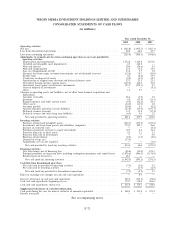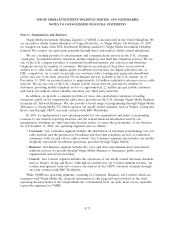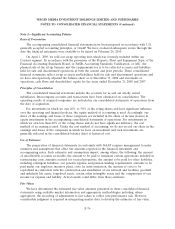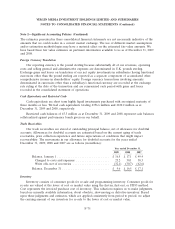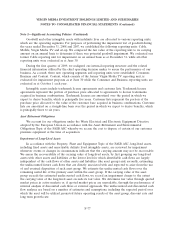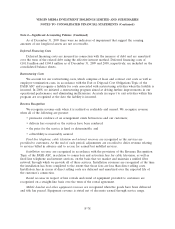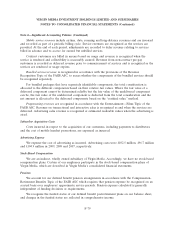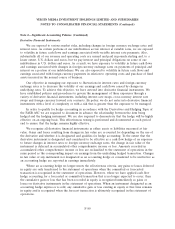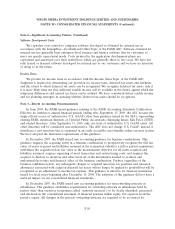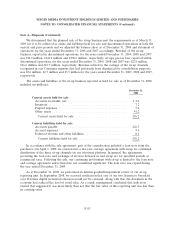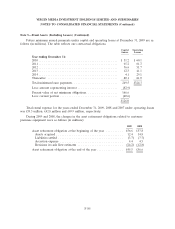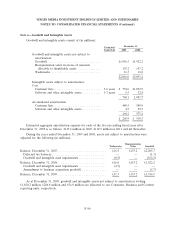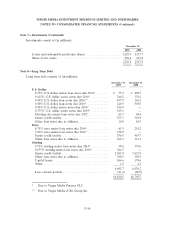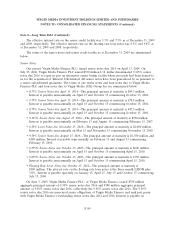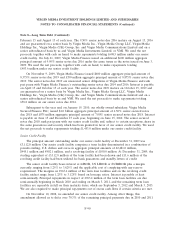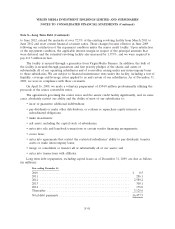Virgin Media 2009 Annual Report Download - page 177
Download and view the complete annual report
Please find page 177 of the 2009 Virgin Media annual report below. You can navigate through the pages in the report by either clicking on the pages listed below, or by using the keyword search tool below to find specific information within the annual report.VIRGIN MEDIA INVESTMENT HOLDINGS LIMITED AND SUBSIDIARIES
NOTES TO CONSOLIDATED FINANCIAL STATEMENTS (Continued)
Note 2—Significant Accounting Policies (Continued)
Software Development Costs
We capitalize costs related to computer software developed or obtained for internal use in
accordance with the Intangibles—Goodwill and Other Topic of the FASB ASC. Software obtained for
internal use has generally been enterprise-level business and finance software that we customize to
meet our specific operational needs. Costs incurred in the application development phase are
capitalized and amortized over their useful lives, which are generally three to five years. We have not
sold, leased or licensed software developed for internal use to our customers and we have no intention
of doing so in the future.
Income Taxes
We provide for income taxes in accordance with the Income Taxes Topic of the FASB ASC.
Judgment is required in determining our provision for income taxes, deferred tax assets and liabilities
and the extent to which deferred tax assets can be recognized. We recognize deferred tax assets only if
it is more likely than not that sufficient taxable income will be available in the future against which the
temporary differences and unused tax losses can be utilized. We have considered future taxable income
and tax planning strategies in assessing whether deferred tax assets should be recognized.
Note 3—Recent Accounting Pronouncements
In June 2009, the FASB issued guidance relating to the FASB Accounting Standards Codification.
Effective for interim or annual financial periods ending after September 15, 2009, the ASC became the
single official source of authoritative U.S. GAAP (other than guidance issued by the SEC), superseding
existing FASB, American Institute of Certified Public Accountants, Emerging Issues Task Force (EITF),
and related literature. After September 15, 2009, only one level of authoritative U.S. GAAP exists. All
other literature will be considered non-authoritative. The ASC does not change U.S. GAAP; instead, it
introduces a new structure that is organized in an easily accessible, user-friendly online research system.
We have adopted the disclosure requirements of this guidance.
In December 2007, the FASB issued new accounting guidance for business combinations. This
guidance requires the acquiring entity in a business combination to prospectively recognize the full fair
value of assets acquired and liabilities assumed in the transaction (whether a full or partial acquisition);
establishes the acquisition-date fair value as the measurement objective for all assets acquired and
liabilities assumed; requires expensing of most transaction and restructuring costs; and requires the
acquirer to disclose to investors and other users all of the information needed to evaluate and
understand the nature and financial effect of the business combination. Further, regardless of the
business combination date, any subsequent changes to acquired uncertain tax positions and valuation
allowances associated with acquired deferred tax assets will no longer be applied to goodwill but will be
recognized as an adjustment to income tax expense. This guidance is effective for financial statements
issued for fiscal years beginning after December 15, 2008. The adoption of this guidance did not have a
material impact on our consolidated financial statements.
In December 2007, the FASB issued new accounting guidance for noncontrolling interests in
subsidiaries. This guidance establishes requirements for ownership interests in subsidiaries held by
parties other than ourselves (sometimes called ‘‘minority interests’’) to be clearly identified, presented,
and disclosed in the consolidated statement of financial position within equity, but separate from the
parent’s equity. All changes in the parent’s ownership interests are required to be accounted for
F-81


